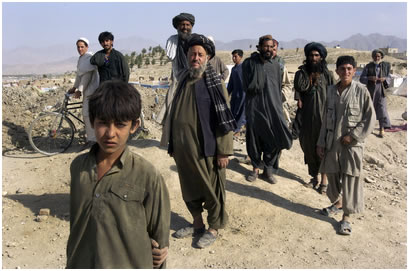Topic 2: The global context of humanitarian relief
The role of the media
Coping with Disaster
Refugees in Ethiopia
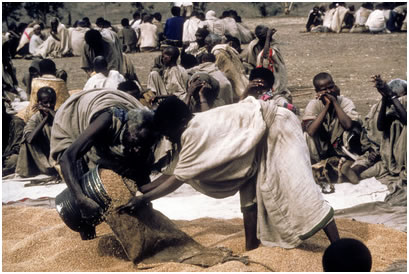
Grains donated by various international organisations being distributed at the Lalibela relief station in the Province of Wallo, January 1983, Ethiopia
Source: http://www.foun.org.au, Photo # 29543, accessed April 2011
The Ethiopian war with Eritrea in the early 1980’s was exacerbated by drought, and it was here that modern technology, particularly in the form of TV coverage, began to make dramatic breakthroughs in media attention, particularly in Western household sitting rooms. This was highlighted by the now famous BBC report by Michael Burke on the Ethiopian Famine, which in turn resulted in Bob Geldof and his rock star colleagues organising massive popular initiatives such as Band Aid and Live Aid. These in turn contributed to massive relief efforts for the affected areas, and ultimately the collapse the Ethiopian Dergue government and the establishment of an independent Eritrea. Tom Keneally has recently written an insightful book on the Ethiopian Famine (Entitled Three Famines, it includes a study of the nineteenth century Irish, and the 1943/44 Bengal, famines. It is a fascinating case study into some of the complexities of the background social, political and economic situations leading up to major famine situations.
The media also played important roles on two other major humanitarian situations of the 1980’s, both of these initially linked to proxy Cold War alignments. Vietnam invaded Kampuchea (Cambodia) in 1979 to overthrown the Khmer Rouge regime, but throughout the following decade Western (and other) countries supported a range of resistance organisations along the Thai border, with both humanitarian assistance to support Cambodian refugees, but also with weapons to fight the Vietnamese occupation army in Cambodia. A similar situation developed in Pakistan, where again both Western, Saudi Arabian and other countries supported Afghan refugees with humanitarian assistance, but also the cartel of mujaheddin, resistance groups, many based in Pakistan, which were fighting Soviet occupation troops in Afghanistan. Soviet forces withdrew from Afghanistan in 1989; the capital Kabul fell to mujaheddin forces in 1992, which then began to fight amongst themselves. The Taliban took power around Kandahar in 1994 and occupied Kabul in 1996.
The collapse of the Soviet Union, and the subsequent start of democratisation process of many of its Warsaw Pact allies over 1989-91, resulted in the end of the Cold War, and the beginning of what was initially heralded as a ‘New World Order’. Initially there were high hopes of reversing and dealing with historically difficult situations, and this was the beginning of the decade (the 1990’s) when the growth of peace-keeping operations grew exponentially. An early example of this was the United Nations Transitional Authority in Cambodia (UNTAC) in 1992-4, which oversaw the repatriation of approximately 300,000 Cambodian refugees back to their homeland, and the facilitation of civilian elections. Whilst flawed in a number of respects, it involved successful cooperation of UN civilian, military & police personnel, and was generally regarded as an overall success.
Other UN-administered operations which followed during the 1990’s resulted in less successful outcomes, and in particular the following three are of note:
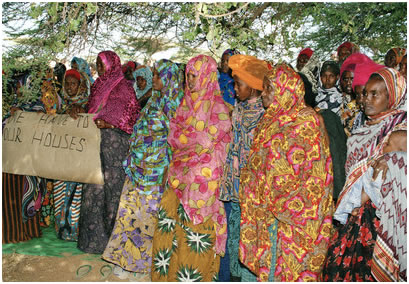
United Nations Operation in Somalia (UNOSOM) Somali women, including elders of the community, assembled for a meeting with Admiral Jonathan T. Howe, Special Representative of the Secretary-General for Somalia, 01 April 1993, Jilib, Somalia Source: http://www.foun.org.au Photo # 78590, accessed April 2011 |
Somalia (1992-5) Initially planned as a humanitarian intervention due to drought and break-down of governance, this ultimately resulted in failure. This was due partially to the over-stepping of its designated UN humanitarian and peace-keeping mandate by UN (mainly US) forces. This resulted in the killing of UN/US forces, and ultimately the unwillingness of the US to involve itself militarily in new UN humanitarian operations, particularly those in Africa |
Rwanda (1994) There was initially a relatively small, primarily Belgian, UN peace-keeping force in place, but the assassination of the Rwandan and Burundi Presidents, combined with the murder of some of these peace-keepers, caused UN to mainly withdraw its forces. It was thus unable to stop the resultant large-scale massacre (800,000 +people) of mainly Tutsi and moderate Hutus by Hutu Interahamwe militia.
|
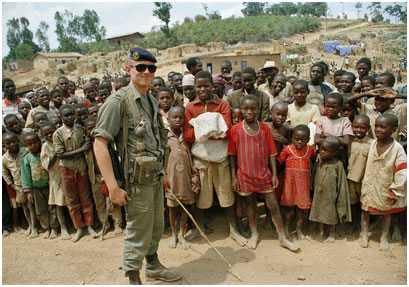
United Nations Assistance Mission for Rwanda A French soldier protecting a camp in Gikongoro, 27 July 1994, Gikongoro, Rwanda Source: http://www.foun.org.au Photo # 143622, accessed April 2011 |
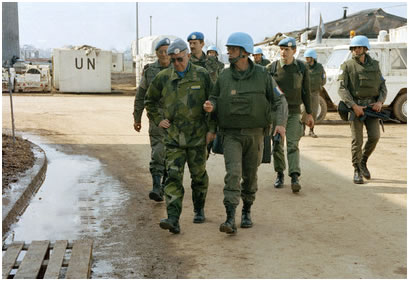
United Nations Protection Force (UNPROFOR) Lieutenant-General Lars-Eric Wahlgren (left, foreground), UNPROFOR Force Commander, and Lieutenant-General Philippe Morillon (far left, behind General Wahlgren), UNPROFOR's Bosnia-Herzegovina Commander, on their way to a meeting in Sarajevo. April 1993. Sarajevo, Bosnia and Herzegovina. Source: http://www.foun.org.au Photo # 131444, accessed April 2011
|
Bosnia-Herzegovina (1992-5) Following break-up of the Former Yugoslavia, and subsequent war between Serbia-Croatia there was then bloody conflict over former Bosnia (which was ethnically split between Serbs/Croats/Muslims). Mainly European UN peace-keepers were deployed to limit the fighting, and provide humanitarian corridors of assistance. However they were unable to prevent the massacre of 7,000 mainly Moslem men at Srebenica by Serb militia in July 1995, an event which led to much more robust military intervention, but this time under a NATO (North Atlantic Treaty Organisation), rather than UN, flag. |
Conclusion

Schoolchildren in North Darfur
Children at school in Arabashir village near El Fasher, North Darfur.
21 November 2010, El Fasher, Sudan.
Source: http://www.foun.org.au Photo # 456885, accessed April 2011
From the early 1990’s there was an initial sharp increase in peace-keeping operations, and the Cambodian resettlement program saw large numbers of western countries involved in military and police UN peace-keeping operations. However the débâcles of UN operations in Somalia, Rwanda, and the Balkans, led to fewer deployments of Western troops involved in future UN peacekeeping operations. Increasingly non-Western troops began to take the major roles in UN peace-keeping operations, examples of this being in Darfur (a hybrid UN/AU mission comprising mixture of African , Asian and European Union countries), Democratic Republic of Congo (Asians and Latin Americans) and Haiti (again primarily Latin Americans and Asians).
There was also an increase in non-UN military and police intervention in complex political/military/ humanitarian operations. Examples of these were the NATO forces in Kosovo (1991 onwards); West African ECOMOG (Economic Community of West African States Monitoring Group (ECOMOG), primarily Nigerian troops supported by other countries such as Ghana and other West African countries) forces in Liberia, Guinea-Bissau and Sierra Leone; African Union (AU) forces in Somalia; NATO forces (although sanctioned by the UN) in Afghanistan (2002 onwards); the ‘Coalition of the Willing’ (mainly US/UK forces, but not sanctioned by the UN) in Iraq (2003-2010). In March 2011, a NATO-led, but UN/Arab league/African Union-supported ‘No-fly Zone’ was established over Libya to protect civilians fighting against the regime of the incumbent President, Colonel Gaddafi.
Two particular complex conflict situations have over the past decade transformed the situations in which conflict and humanitarianism co-exist. The first was the invasion of Afghanistan in late 2001 following the destruction of the New York World Trade Centre towers on the 9th September 2001 (commonly referred to as 9/11).
The relatively rapid defeat of Taliban government forces, and the flight of al-Qaeda fighters into bases in Pakistan, opened up a long, complex bloody situation. Mainly Western forces continued to battle main Taliban insurgents in the countryside; whilst an increasingly ineffective Afghan government struggled to impose good governance and economic development throughout much of the country. Iraq in turn was then invaded in 2003, and whilst internal conflict has to a great extent diminished relatively since 2010, the economic and social structure of that country remains fragile. Both situations have created widespread debate and angst, as for many they represent a perceived clash of civilisations, pitching mainly Western armed forces on one side against a mixture of nationalistic, mainly Moslem forces on the other. |
|
Linda Polman, author of War Games: The story of aid and war in modern times, asserts that: …in practice journalists scarcely question aid organisations. They are content to let NGOs guide them around refugee camps, for example. If such a camp were in the Netherlands or the UK and contracted out not to an NGO but to a care company or a catering firm, then journalists would want to know precisely why it was needed, whether in fact it really was needed, how much money was being raked off and by whom, whether the aid workers had the proper diplomas for aid work, whether they were paying due attention to the rights of residents, to neighbours and to the environment, what kind of aftercare the care companies intended to provide and whether or not local authorities were sharing the benefits. But when it comes to aid agencies, journalists automatically approve (Polman, 2010, p162). |
|
 |
|
Along with Linda Polman, I’d like you to consider the question: What responsibilities should we ourselves recognise, as donors to aid organisations? |
|
